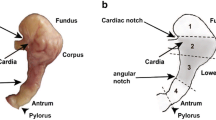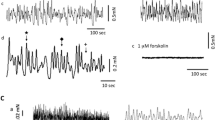Summary
Isolated rabbit gastric glands were used to study the nature of the muscarinic cholinergic responses of parietal cells. Carbachol (CCh, 100 μm) stimulation of acid secretion, as measured by the accumulation of aminopyrine, was inhibited by the M1 antagonist, pirenzepine, with an IC50 of 13 μm; by the M2 antagonist, 11,2-(diethylamino)methyl-1 piperidinyl acetyl-5,11-dihydro-6H-pyrido 2,3-b 1,4 benzodiazepin-6-one (AF-DX 116), with an IC50 of 110 μm; and by the M1/M3 antagonist, diphenylacetoxy-4-methylpiperidinemethiodide (4-DAMP), with an IC50 of 35nm. The three antagonists displayed equivalent IC50 values for the inhibition of carbachol-stimulated production of14CO2 from radiolabeled glucose, which is a measure of the turnover of the H,K-ATPase, the final step of acid secretion. Intracellular calcium levels were measured in gastric glands loaded with FURA 2. Carbachol was shown to both release calcium from an intracellular pool and to promote calcium entry across the plasma membrane. The calcium entry was inhibitable by 20 μm La3+. The relative potency of the three muscarinic antagonists for inhibition of calcium entry was essentially the same as for inhibition of acid secretion or pump related glucose oxidation. Image analysis of the glands showed the effects of carbachol, and of the antagonists, on intracellular calcium were occurring largely in the parietal cell. The rise in cell calcium due to release of calcium from intracellular stores was inhibited by 4-DAMP with an IC50 of 1,7nm, suggesting that the release pathway was regulated by a low affinity M3 muscarinic receptor or state; Ca entry and acid secretion are regulated by a high affinity M3 muscarinic receptor or state, inhibited by higher 4-DAMP concentrations (>30nm), suggesting that it is the steady-state elevation of Ca that is related to parietal cell function rather than the [Ca] i transient. Displacement of3H N-methyl scopolamine (NMS) binding to purified parietal cells by CCh showed the presence of two affinities for CCh, but only a single affinity for 4-DAMP and lower affinity for pirenzepine and AFDX 116, providing further evidence for the parietal cell location of the [Ca] i response. Elevation of steady-state [Ca] i levels with either ionomycin or arachidonic acid did not replicate M3 stimulation of acid secretion or glucose oxidation, hence elevation of [Ca] i is necessary but not sufficient for acid secretion.
Similar content being viewed by others
References
Berglindh, T. 1977a. Potentiation by carbachol and aminophylline of histamine and db-cAMP induced parietal cell activity in isolated gastric glands.Acta Physiol. Scand. 99:75–84
Berglindh, T. 1977b. Effects of common inhibitors of gastric acid secretion on secretagogue induced respiration and aminopyrine accumulation in isolated gastric glands.Biochim. Biophys. Acta 464:217–233
Berglindh, T., Helander, H.F., Obrink K.J. 1976. Effects of secretagogues on oxygen consumption, aminopyrine accumulation and morphology in isolated gastric glands.Acta Physiol. Scand. 97:401–414
Berglindh, T., Obrink, K.J. 1976. A method for preparing isolated gastric glands from rabbit gastric mucosa.Acta Physiol. Scand. 96:150–159
Berglindh, T., Sachs, G., Takeguchi, N. 1980. Ca2+ dependent secretagogue stimulation in isolated gastric glands.Am. J. Physiol. 239:G90-G94
Bergqvist, E., Obrink, K.J. 1979. Gastrin-histamine as a normal sequence in gastric acid stimulation in the rabbit.Uppsala J. Med. Sci. 84:145–154
Brown, M.R., Chew, C.S. 1989. Carbachol induced protein phosphorylation in parietal cells: Regulation by [Ca2+] i .Am. J. Physiol. 257:G99-G110
Buckley, N.J., Bonner, T.I., Buckley, T.I., Brann, M.R. 1989. Antagonist binding properties of five cloned muscarinic receptors expressed in CHO-KI cells.Mol. Pharmacol. 35:469–476
Cheng, Y., Prusoff, W.H. 1973. Relationship between the inhibition constant (KI) and the concentration of an inhibitor that causes a fifty percent inhibition (IC50) of an enzymatic reaction.Biochem. Pharmacol. 22:3099–3108
Chew, C.S. 1985. Differential effects of extracellular calcium removal and non-specific effects of Ca2+ antagonists on acid secretory activity in isolated gastric glands.Biochim. Biophys. Acta 846:370–378
Chew, C.S., Brown, M.R. 1986. Release of intracellular Ca2+ and elevation of inositol triphosphate by secretagogues in parietal and chief cells isolated from rabbit gastric mucosa.Biochim. Biophys. Acta 888:116–125
Chew, C.S., Hersey, S.J., Sachs, G., Berglindh, T. 1980. Histamine responsiveness of isolated gastric glands.Am. J. Physiol. 238:G312-G320.
Conklin, B.R., Brann, M.R., Buckley, N.J., Ma, A.L., Bonner, T.I., Axelrod, J. 1988. Stimulation of arachidonic acid release and inhibition of mitogenesis by cloned genes for muscarinic receptor subtypes stably expressed in A9L cells.Proc. Natl. Acad. Sci. USA 85:8698–8702
Culp, P.J., Wolosin, J.M., Soll, A.H., Forte, J.G. 1983. Muscarinic receptors and guanylate cyclase in mammalian gastric cells.Am. J. Physiol. 245:G641-G646
Florio, V.A., Sternweiss, P.C. 1985. Reconstitution of resolved muscarinic cholinergic receptors with purified GTP binding proteins.J. Biol. Chem. 260:3477–3483
Fryklund, J., Gedda, K., Scott, D., Sachs, G., Wallmark, B. 1990. Coupling of H+K+-ATPase activity and glucose oxidation in gastric glands.Am. J. Physiol. 258:G719-G727
Grykiewicz, G., Poenie, M., Tsien, R.Y. 1985. A new generation of Ca2+ indicators with greatly improved fluorescence properties.J. Biol. Chem. 260:3440–3450
Hersey, S.J. 1977. Metabolic changes associated with gastric stimulation.Gastroenterology 73:914–919
Hersey, S.J., Chew, C.S., Campbell, L., Hopkins, E. 1981. Mechanism of action of SCN in isolated gastric glands.Am. J. Physiol. 240:G232-G238
Hirschowitz, B.I., Molina, E. 1983. Effects of four H2 histamine antagonists on bethanechol stimulated acid and pepsin secretion in the dog.J. Pharmacol. Exp. Ther. 224:341–345
Hulme, E.C., Birdsall, N.J.M., Buckley, N.J. 1990. Muscarinic receptor subtypes.Ann. Rev. Pharmacol. Toxicol. 30:633–673
Kajimura, M., Haga, T., Ichiyama, A., Kaneko, E., Honda, N. 1990. Carbachol induced potentiation and inhibition of acid secretion by guinea pig gastric gland.Eur. J. Pharmacol. 178:59–69
Liao, C.F., Themmen, A.P.N., Joho, R., Barberis, C., Birnbaumer, M., Birnbaumer, L. 1989. Molecular cloning and expression of a fifth muscarinic acetylcholine receptor.J. Biol. Chem. 265:7328–7337
Merrit, J.E., Rink, T.J. 1987. Regulation of cytosolic free calcium in fura-2 loaded rat parotid acinar cells.J. Biol. Chem. 262:17362–17369
Mitchelson, F. 1988. Muscarinic receptor differentiation.Pharmacol. Ther. 37:357–423
Muallem, S., Blissard, D., Cragoe, E.J., Sachs, G. 1988. Activation of the Na/H and Cl/HCO3 exchange by stimulation of acid secretion in the parietal cells.J. Biol. Chem. 263:14703–14711
Muallem, S., Burnham, C., Blissard, D., Berglindh, T., Sachs, G. 1985. Electrolyte transport across the basal lateral membrane of the parietal cell.J. Biol. Chem. 260:6641–6653
Muallem, S., Sachs, G. 1985. Ca2+ metabolism during cholinergic stimulation of acid secretion.Am. J. Physiol. 248:G216-G228
Negulescu, P.A., Reenstra, W.W., Machen, T.E. 1989. Intracellular Ca requirements for stimulus-secretion coupling in parietal cell.Am. J. Physiol. 256:C241-C251
Paradiso, A.M., Tsien, R.Y., Machen, T.E. 1987. Digital image processing of intracellular pH in gastric oxyntic and chief cells.Nature 325:447–450
Petersen, O.H., Muruyama, Y. 1983. What is the mechanism of the calcium influx to pancreatic acinar cells evoked by secretagogues?Pfluegers Arch. 396:82–84
Pfieffer, A., Rochlitz, H., Noelke, B., Tacke, R., Moser, U., Mutschler, E., Lambrecht, G. 1990. Muscarinic receptors mediating acid secretion in isolated rat gastric parietal cells are of M3 type.Gastroenterology 98:218–222
Pinkas-Kramarski, R., Stein, R., Zimmer, Y., Sokolovsky, M. 1988. Cloned rat M3 muscarinic receptors mediate phosphoinositide hydrolysis, but not adenylate cyclase inhibition.FEBS Lett. 239:174–178
Rabon, E., Cuppoletti, J., Malinowska, D., Smolka, A., Helander, H.F., Mendlein, J., Sachs, G. 1983. Proton secretion by the gastric parietal cell.J. Exp. Biol. 106:119–133
Rana, R.S., Hokin, L.E. 1990. Role of phosphoinositides in transmembrane signalling.Physiol. Rev. 70:115–164
Schubert, M.L., Bitar, K.N., Makhlouf, G.M. 1982. Regulation of gastrin and somatostatin secretion by cholinergic and noncholinergic intramural neurons.Am. J. Physiol. 243:G442-G447
Soll, A.H. 1978. The interaction of histamine with gastrin and carbamylcholine in oxygen uptake by isolated mammalian parietal cells.J. Clin. Invest. 61:381–389
Sutliff, V.E., Rattan, S., Gardner, J.D., Jensen, R.T. 1989. Characterisation of cholinergic receptors mediating pepsinogen secretion from chief cells.Am. J. Physiol. 257:G226-G234
Author information
Authors and Affiliations
Rights and permissions
About this article
Cite this article
Wilkes, J.M., Kajimura, M., Scott, D.R. et al. Muscarinic responses of gastric parietal cells. J. Membrain Biol. 122, 97–110 (1991). https://doi.org/10.1007/BF01872634
Received:
Revised:
Issue Date:
DOI: https://doi.org/10.1007/BF01872634




